Cubans Visit their Ancestral Home in Africa
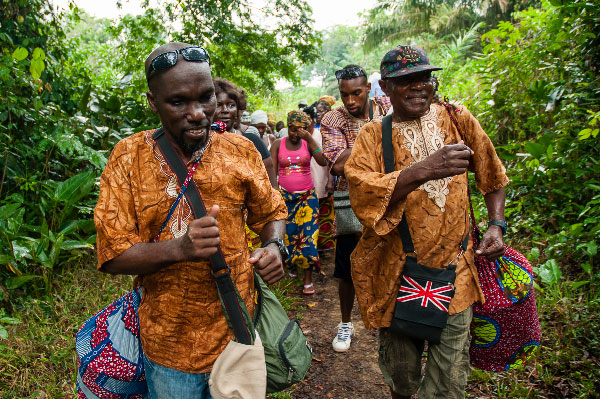
By Emma Christopher (Photos Sergio Leyva Seiglie)
HAVANA TIMES — There are very few good news stories to come out of the transatlantic slave trade, but there was one recently in Sierra Leone.
Around 180 years after their ancestor left aboard a slave ship, four Cubans—Humberto Casanova, Alfredo Duquesne, Elvira Fumero Añí and Yandrys Izquierdo—visited the chiefdom she once called home.
Their ancestral roots have been traced by Dr. Emma Christopher, of the University of Sydney in Australia, using a collection of songs and dances this small group of Cubans has kept alive.
After several years of research across Liberia and Sierra Leone, their origin was traced to Sierra Leone’s Upper Banta chiefdom, where several of the Cubans’ songs and one of their dances were identified as part of the initiation rite of the now-defunct Menda secret society.
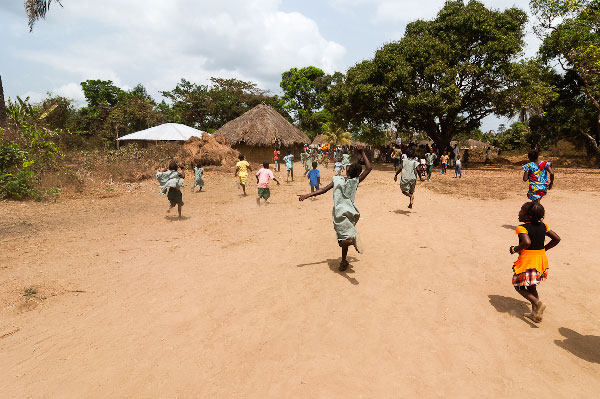
Nobody in either Sierra Leone or Cuba is a fluent Banta speaker anymore—the language has died out—but incredibly people on both sides of the Atlantic Ocean still sung songs in the old dialect.
It was enough for the people in Upper Banta to recognize the Cubans’ songs and claim them as family. “They Are We”, a man named Solomon Musa said as he watched footage of the Cubans’ culture the first time Dr. Christopher visited his village.
Others in the surrounding area told of old stories passed on from their ancestors of people stolen away into slavery, including an entire initiation group from the Menda society who were taken just before their initiation rites were complete.
Whether the Cubans’ ancestor was one of that group is impossible to prove, but to some of the old people in Upper Banta it seems that their ancestors’ stories of stolen people have been proved true. From the first time they saw footage of the Cuban group’s cultural performance, they asked whether the Cubans might be able to visit so that they could all be together “as brothers and sisters”.
It took a couple of years for that to come about, because it was difficult for the Cubans to get permission to travel. With the recent change in the law, however, four of their number was at last able to return to their ancestral homeland.
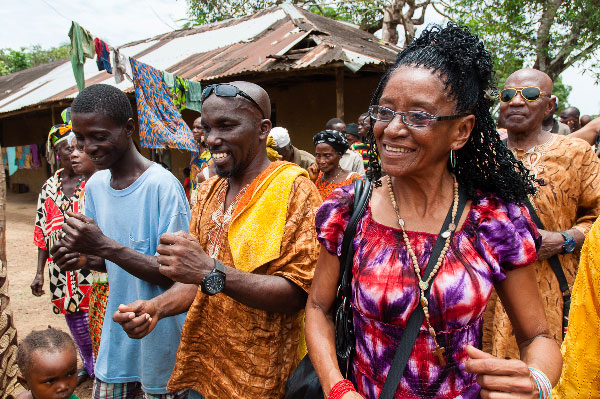
The warmth of the welcome was certainly worth the wait. First visiting Paramount Chief Tommy Jombla in Banta Mokele, both the local people—led with beautiful singing by Christianne Jombla, the chief’s granddaughter—and then the Cubans, drummed, sang and danced in a day of sheer joy.
The Cuban’s chief singer, Elvira Fumero Añí, became overwhelmed with emotion and tears poured down her face. “I’ve never felt so accepted,” she said, speaking of the importance of knowing your origins. Even Chief Jombla joined in the dancing.
After visiting the Chiefdom headquarters, the party went to the village of Mokepie, where Mama Lucy Amara, the last head of the Menda Society,greeted them.
She showed them the medicine house that belonged to the society, which was partly destroyed in the civil war during the 1990s. Expressing her desire to get the society restarted, Mama Lucy was delighted to hear that some Menda traditions are carried on in Cuba. She and Elvira later shopped and cooked together, building up genuine affection regardless of the language gap.
The culmination of the trip was a week’s stay in the ancient village of Mokpangumba. Accompanied by Mama Lucy, the Cubans walked towards the village (which has no motor road access) to the sound of drumbeats and singing. No less than four masked devils from the secret societies and virtually the entire village had turned out to celebrate their arrival.
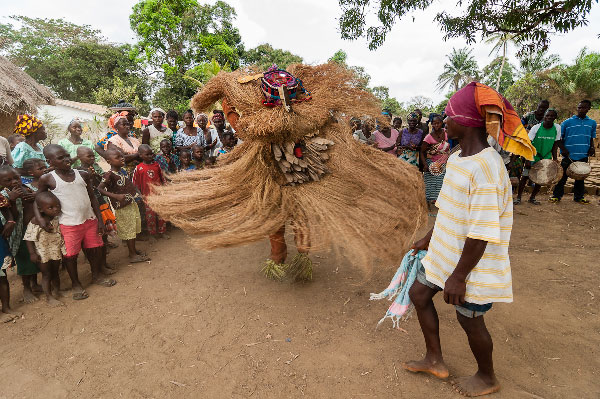
There were cries of delight as Cubans and Sierra Leoneans who had seen each other on film recognized each other in person and went to greet each other with warm hugs and laughter. It was the start of a visit that would be life-changing for many of those involved.
The visitors were determined not to just be tourists. They were clear about wanting to experience village life as it is now. One of the visitors, woodcarver and artist Alfredo Duquesne, visited the farm of Baggie Kpanabum and learned to climb palm trees and cut down the kernels and then process it into palm oil.
Mr. Kpanabum was very surprised, saying that even some people in the village don’t know how to do this work so he had no idea that somebody from overseas would come and learn.
The Cubans also taught the local youth to play their national sport: baseball. But the local team’s defeat on the baseball field was soon revenged when the Saloneans were able to show off their own national sport.
Fielding a team comprised of both the Cuban visitors, members of the crew filming a documentary about the visit (Cuban photographer and field producer Sergio LeyvaSeiglie, Cuban cinematographer Javier Labrador Deulofeu and Barmmy Boy Mansaray from Sierra Leone) as well as some locals drafted in to assist, the ‘away’ side was beaten 1-0 by the experienced locals, despite their generous hosts playing gently.
For the duration of the stay there was a great deal of singing, dancing, and drumming. The few songs still known by both groups were enjoyed many times, with detailed discussions of the different ways that words are now pronounced.
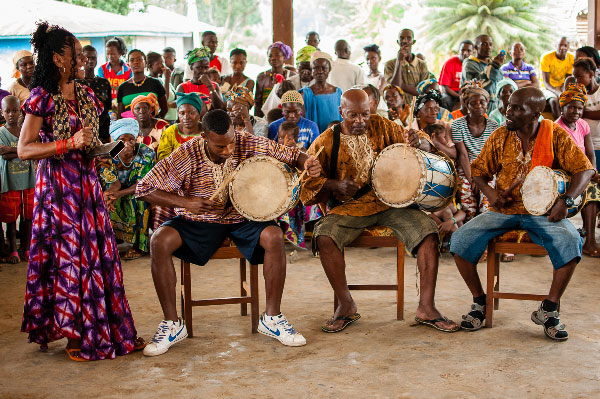
There was also sharing of songs that have not survived in Cuba and teaching of new songs that the Cuban group had composed more recently.
Joe Allie, an elderly man in Mokpangumba who stared in wonder when he first heard a recording of the Cubans singing a song which had once been his grandfather’s favourite, danced for the first time in twenty years. And he kept dancing. He even readily attempted some newer Cuban dances, including the cha-cha-cha and the rumba.
The affection of the village towards the visitors was astonishing. Each day people showed up with gifts, and their tolerance for these people with whom they no longer shared any language, or much culture beyond the old songs and dances, made the trip an unforgettable experience.
Leaving the village was wrenching, with ‘brothers’ such as Alfredo Duquesne and Baggie Kpanabum swapping clothing and photographs, determined to keep in touch.
The challenge now for all involved is to build bridges from this beginning. To build again a community from one so long ago broken by transatlantic slavery is an unprecedented project but a worthy one.
Perhaps, just perhaps, through the forming of these new ties, better days can dawn for both Mokpangumba—which badly needs many amenities—and for the Cubans who have long felt rootless and isolated.
It is a major undertaking and how best to do that is something only decided by discussion and thought on both sides. But surely together is better than apart, even after almost two centuries of separation. “We need to help each other,” said Duquesne, “that’s what families do.”
—–
See facebook.com/theyarewethemovie for more information and photographs. A documentary about the entire project, called ‘They Are We’ will be released later in 2013.
Also see this related post: Cuba/Africa: An Old Slave Trading Post.
Click on the thumbnails below to view all the photos in this gallery. On your PC or laptop, you can use the directional arrows on the keyboard to move within the gallery. On cell phones use the keys on the screen.


























Part of my family is from sierre leone their is a whole documentary on my family call “The language we Cry In” can you please get in contact with me my email is [email protected]
The human aventure, can transform a wrongdoing in a celebration if we focus in the present moment
Maybe you are one of my lost cousins. I am Jamaican but my maternal grandmother and other members of my family were born in Cuba. 🙂
Interesting and revealing times here; “Things once fell apart but thank God they are now clubbing together”
“Devil” or Egun (ancestor)??…..very, very different and sounds alot like Christianity is thrown in.
it is a touching story,we hope and pray that many afro americans will one day did the same thing that this cubans do to trace their background.
Excellent! Family reunion….absolutely! I look forward to my day
Matanzas
What part of Cuba were these folks from?
Here is a short video about this story https://www.youtube.com/watch?v=ag2bdBRABmg
I love this and as a Barbadian I want this to happen in my country I love to know where I come from, to know my people, so as a visual artist I can understand where my energy comes from, I love this part here, “I’ve never felt so accepted,” I want to fell like I really belong somewhere and that I am really part of a bigger community that celebrates together one union one people.
There is nothing like being an AFRO CUBAN!
BEAUTIFUL STORY!! KEEP RETURNING TO AFRICA. WE ALL NEED TO LIVE WHERE WE BELONG AND CAN LIVE IN HARMONY.
It’s touching for me too because the ancestors of this distant home lives in me also.
Hearts whisper across ages
Tears not dried by the scorching sands of time
Turn to joy with the blend of timeless beats
Finally laid to rest in a mama’s sigh
Hear the whisper, hear the whisper
I love this. It has mande the hairs on my skin ris.Why? Because the are from the same mende tribe as my mother and myself,and the head of the secret society shares the same name as me ‘Mama Lucy’ or Mama Lu as im called for shrt after my maernal grandmother who was a tribal dancer (sowei) and head of a secret society. I have always been intriguied with cuba as a must do desination as I have felt a connection with their vibrant afican mix of cultures. Anyone interested in visiting sierra-leone again I would suggest a village in the town of Njala called Mokonday (My ancestoral Village!). I will be visiting next Decemeber 2014 by gods grace…if anyone is interested??
This is so touching…we are all brothers and sisters in this global village
I, too, was moved by this article, and am glad that Elvira, Yandrys, Humberto and Alfredo were able to go home again. I’d love to hear the music that they, and their Sierra Leonese ancestors, shared, but will have to wait ’til the joint Cuban-Sierra Leonese documentary is released. In the meantime, I’ll have to be content with the field recordings made my Lydia Cabrera and Josefina Tarafa [“Matanzas, Cuba, ca. 1957: Afro-Cuban Sacred Music from the Countryside,” Smithsonian Folkways Recordings, http://www.si.edu/folkways, c. 2001], and other such recordings. Thank you, Emma for sharing this with the readers of HT, and for your landmark work in tracking down the origins of this music.
This makes me cry. I heard about this documentary a few weeks ago and was so excited about it.
a superb reunion by a people who have shown the world despite their hardships of the past that they now have a real future in todays world. regretfully creed and colour still exists, but as a Scotsman I believe that the words of Scotland’s World poet the words “then let us pray that come what may, as come it will for a’ that….
that man to man, the world o’er, shall brothers be for ‘a that”
we ALL MUST STRIVE FOR THIS GOAL.
This is a deeply touching article. Our human family is truly one. Thank you, Emma Christopher, for sharing the adventure.
Heart warming and touching
Thrilling!